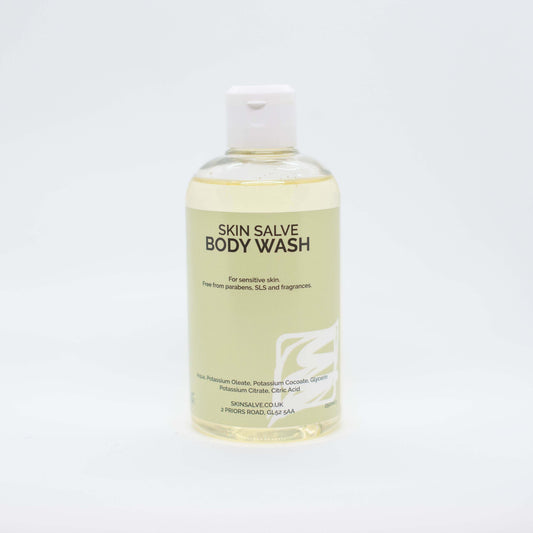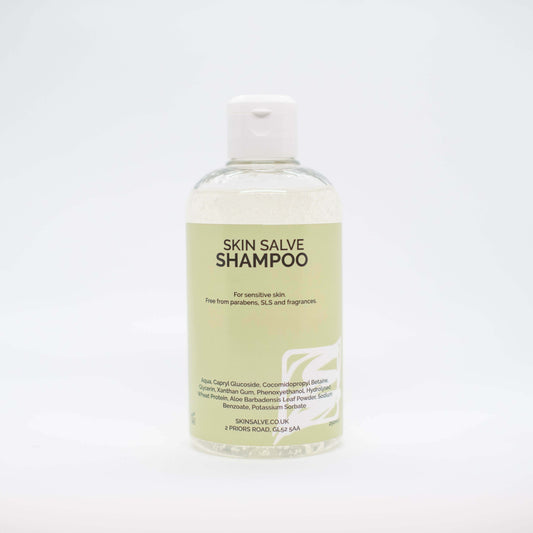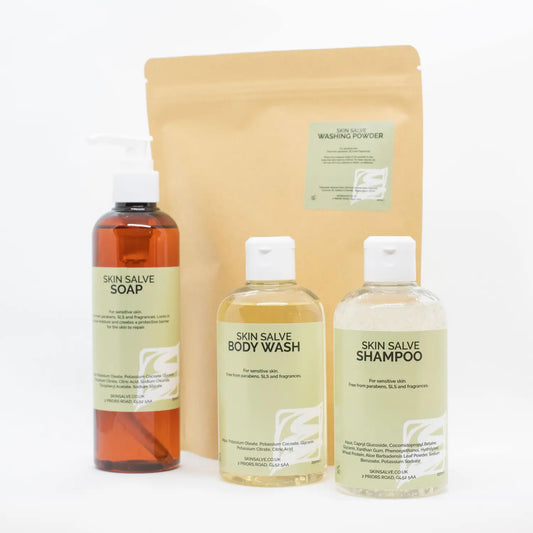Ingredients in Skin Salve’s Sensitive Skin Care Range
See below to know what you’re putting on your skin, and why.
It can sometimes be confusing working out what’s in your skin care products and whether they are good or bad for your skin. Over years of helping people treat their dry skin conditions we’ve learnt that our products are “life-saving” for some, and for others they don’t seem to help.
Some people already know what ingredients trigger their skin, others are still finding out.
The table below includes all our ingredients and the products that use them. Each has an explanation, its synonym and a EWG Skin Deep Score.
Ingredients
A to E
Aloe Barbadensis
Also known as:
- Aloe Barbadensis (Aloe Vera) Gel
- Aloe Gel
- Aloe Juice
- Aloe Vera Gel
- Aloe Vera Juice
- Aloe Vera Leaf Gel
EWG Rating: 1-3 depending on usage
Explanation: Aloe vera juice is produced from the succulent leaves of the aloe plant, Aloe barbadensis.
Found in:
Aqua
Also known as:
- Aqua
- Deionized Water
- Distilled Water
- Onsen-Sui
- Purified Water
- Water
EWG Rating: 1
Explanation: Also known as water
Found in:
Buxus Chinensis
Also known as:
- Buxus Chinensis (Jojoba) Oil
- Buxus Chinensis Oil
- Jojoba Wax
- Jojoba Oil
- Jojoba Seed Oil
EWG Rating: 1
Explanation: Jojoba oil is extracted from seeds of the desert shrub, Simmondsia chinensis.
Found in:
Caprylyl Glucoside
Also known as:
- Caprylyl/ Capryl Glucoside
EWG Rating: 2
Explanation: A highly effective natural and biodegradable surfactant that is easy to use and easily creates Shower Gels, Shampoos, Face Wash and other foaming cosmetics
Found in:
Carbomer
Also known as:
- Carbomer
- Carbomer 934
EWG Rating: 1
Explanation: Carbomer is a large polymeric chemical composed of acrylic acid monomers, that acts as an emulsion stabiliser/viscosity increasing agent.
Found in:
Cetearyl Alcohol
Also known as:
- (C16-C18) Alkyl Alcohol
- (C16-C18)-Alkyl Alcohol 1
EWG Rating: 1
Explanation: Cetearyl Alcohol is a mixture of cetyl and stearyl alcohols that can come from vegetable or synthetic sources.
Found in:
Citric Acid
Also known as:
- 2-Hydroxy-1,2,3-Propanetricarboxylic Acid
- Anhydrous Citric Acid
- Citric Acid
EWG Rating: 1-2 depending on usage
Explanation: Citric acid is an alpha hydroxy acid used in personal care products to adjust the acidity or promote skin peeling and re-growth in the case of anti-ageing products. Citric acid is naturally found in citric fruits and juices, providing the characteristic acidic taste.
Found in:
Cocamidopropyl Betaine
Also known as:
- Cadg
- Cocamido Betaine
- Cocamidopropyl Betaine
- Cocamidopropyl Dimethyl Glycine
- Cocoamidopropyl BetaineCocoyl
EWG Rating: 1-5, depending on usage. This ingredient’s score is higher if used in products that will not be immediately rinsed off due to increased risk of absorption.
Explanation: Cocamidopropyl betaine is a surfactant.
Found in:
In the Skin Salve SLS-Free Shampoo, the ingredient is washed off immediately.
Coconut Oil
Also known as:
- Coconut Absolute
- Coconut Fatty Acid Triglyceride
- Coconut Oil
- Cocos Nucifera (Coconut) Oil
- Cocos Nucifera Oil
- Copra Oil
EWG Rating: 1
Explanation: Coconut oil is extracted from the kernels of the seeds of coconut palm, Cocos nucifera.
Found in:
Elaeis Guineensis
Also known as:
- African Oil Palm Oil
- Elaeis Guineensis (African Oil Palm) Oil
- Elaeis Guineensis (Palm) Kernel Oil
- Palm Kernel Oils
- Palm Oil
- Palm Seed Oil
EWG Rating: 1
Explanation: Oil obtained from African oil palm, Elaeis guineensis.
Found in:
- Dermasalve Moisturisers
F to H
Glycerin
Also known as:
- Glycerine
- Glycerol
- Glycyl Alcohol
EWG Rating: 1-2 depending on usage
Explanation: Glycerin (also called glycerol) is a naturally occurring alcohol compound and a component of many lipids. Glycerin may be of animal or vegetable origin. This ingredient is listed as a byproduct of soap manufacturing, which typically uses animal fat.
Found in:
Glyceryl Stearate
Also known as:
- Glyceryl Stearate Se
- Octadecanoic Acid, Ester With 1,2,3
- Propanetriol
- Self-Emulsifying Glyceryl Monostearate
- Stearine
EWG Rating: 1
Explanation: Glyceryl Stearate SE (self-emulsifying) is a lipid used as surfactant and emulsifying agent.
Found in:
Healianthus Annuus (Sunflower) Seed Oil
Also known as:
- Sunflower Oil
- Helianthus Annuus (Sunflower) Oil
- Helianthus Annuus (Sunflower) Seed Oil
- Helianthus Annuus Oil
EWG Rating: 1
Explanation: Sunflower oil is extracted from the seeds of the sunflower, Helianthus annuus.
Found in:
Hydrogenated Vegetable Glycerides Citrate
Also known as:
- Glycerides, C821 And C821
- Unsatd. Mono And Di, Citrates
- Hydrogenated Vegetable Glycerides Citrate
EWG Rating: 1
Explanation: A hydrogenated blend of vegetable glycerides that functions chiefly as an emollient and texture enhancer in cosmetics
Found in:
Hydrolysed Wheat Protein
Also known as:
- Glutens, Enzyme-Modified
- Hydrolysate Proteins, Wheat
- Hydrolysed Wheat Protein
- Proteins, Wheat, Hydrolysate
- Wheat Gluten, Enzyme-Modified
- Wheat Hydrolysate Proteins
- Wheat Protein Hydrolysate
EWG Rating: 1-4 depending on usage
Explanation: This ingredient is produced by acid or enzymatic hydrolysis of wheat protein.
Found in:
I to P
Paraffinum Liquidum
Also known as:
- Deobase
- Heavy Mineral Oil
- Light Mineral Oil
- Liquid Paraffin
- Liquid Petrolatum
- Paraffin Oil
- Petroleum
EWG Rating: 1-3 depending on usage - higher if the product can be inhaled.
Explanation: Mineral Oil is a liquid mixture of hydrocarbons obtained from petroleum.
Found in:
Phenoxyethanol
Also known as:
- Ethanol, 2-Phenoxy-Ethanol, 2
- Phenoxy
- Ethylene Glycol Monophenyl Ether
- Phenoxyethanol
- Phenoxytol
EWG Rating: 2-4 depending on usage
Explanation: Phenoxyethanol is a preservative used in cosmetics and personal care products.
Found in:
Phenoxythanol
Also known as:
- 2-Hydroxyethyl Phenyl Ether2-Phenoxy- Ethanol2-Phenoxyethanol2-Phenoxyethyl Alcohol
- Ethanol, 2-Phenoxy-Ethanol, 2
- Phenoxy
- Ethylene Glycol Monophenyl Ether
- Phenoxyethanol
- Phenoxytol
EWG Rating: 2-4 This ingredient’s score is higher if used in products that are inhalable (e.g., sprays, powders) because of respiratory concerns - it is not used in inhalable products for Skin Salve.
Explanation: Phenoxyethanol is a preservative used in cosmetics and personal care products.
Found in:
Polysorbate 20
Also known as:
- Monododecanoate Poly(Oxy-1,2-Ethanediyl) Derivs. Sorbitan
- Poly(Oxy-1,2-Ethanediyl) Derivs. Sorbitan, Monododecanoate
- Polyoxyethylene (20) Sorbitan Monolaurate
- Polyoxyethylene Sorbitan Monolaurate
EWG Rating: 1-3 depending on usage
Explanation: Polysorbate 20 (Tween 20) is a surfactant and emulsifier used in cleaners and personal care products.
Found in:
Potassium Citrate
Also known as:
- Citric Acid, Tripotassium Salt
- Potassium Citrate
- Potassium Tribasic Citrate
- Tripotassium Citrate
- Tripotassium Salt
- Tripotassium Salt Citric Acid
EWG Rating: 1
Explanation: Potassium Citrate is a potassium salt of citric acid.
Found in:
Potassium Cocoate
Also known as:
- Coconut Fatty Acid
- Potassium Salt
- Coconut Fatty Acids
EWG Rating: 1
Potassium Cocoate is a potassium salt of Coconut Acid - created during saponification of Coconut Oil.
Found in:
Potassium Oleate
Also known as:
- 9Octadecenoic Acid (Z), Potassium Salt
- Potassium 9-Octadecenoate
- Potassium Salt 9-Octadecenoic Acid
EWG Rating: 1
Explanation: Potassium Oleate is a potassium salt of oleic acid, it is made from the saponification of vegetable oils.
Found in:
Potassium Sorbate
Also known as:
- 2,4-Hexadienoic Acid
- Potassium Salt 2,4
EWG Rating: 2
Explanation: Potassium sorbate is a potassium salt of sorbic acid, a naturally occurring antimicrobial compound; used as a preservative
Found in:
S to Z
Salicylic Acid
Also known as:
- Benzoic Acid, 2Hydroxy
- O-Carboxyphenol
- O-Hydroxybenzoic Acid
- Phenol-2-Carboxylic Acid
EWG Rating: 4-8, depending on usage
Explanation: Salicylic acid is a naturally occurring and synthetically produced beta hydroxy acid used in skin treatment products.
Found in:
Sodium Benzoate
Also known as:
- Benzoic Acid
- Sodium Salt
- Sodium Benzoate
- Sodium Salt Benzoic Acid
EWG Rating: 1-3 depending on usage.
Explanation: Sodium benzoate is a preservative commonly used in foods, pharmaceuticals and cosmetics.
Found in:
Sodium Chloride
Also known as:
- Rock Salt
- Sodium Chloride
EWG Rating: 1
Explanation: Sodium Chloride is an inorganic salt (also called table salt).
Found in:
Sodium Citrate
Also known as:
- Monosodium Salt Citric Acid
- Sodium Citrate
- Sodium Citratem
- Sodium Dihydrogen Citrate
- Trisodium Citrate
- Trisodium Salt 1,2,3-Propanetricarboxylic Acid
- Trisodium Salt Citric Acid
EWG Rating: 1
Explanation: Cosmetic manufacturers use sodium citrate to adjust the acidity of a product. Citrate, in the form of citric acid, is also found in citric fruits and juices.
Found in:
Sodium Cocoate
Also known as:
- Coconut Fatty Acid
- Sodium Salt
- Coconut Oil Fatty Acids
- Sodium Salts Fatty Acids, Coconut Oil
EWG Rating: 1
Explanation: Sodium cocoate is the sodium salt of fatty acids from coconut oil; lauric acid is the primary component of this oil. It is made from the saponification of coconut oil.
Found in:
Sodium Hydroxide
Also known as:
- Caustic Soda
- Sodium Hydroxide
EWG Rating: 1-4 This ingredient’s score is lower when used as a saponification agent (e.g., soaps and cleansers), like it is in Skin Salve products
Explanation: Used in the production of soap through saponification
Found in:
Sodium Silicate
Also known as:
- Silicic Acid (H4Sio4)
- Silicic Acid
- Sodium Salt
- Silicon Sodium Oxide
- Sodium Salt Silicic Acid
EWG Rating: 2-3 This is higher when used around the eyes, which Skin Salve products are not.
Explanation: Sodium Silicate is a sodium salt of silicic acid.
Found in:
Sodium Tallowate
Also known as:
- Tallow
- Sodium Salt Tallow
- Sodium Tallowate
- Tallow Fatty Acids
EWG Rating: 1
Explanation: Sodium Tallowate is a sodium salt of Tallow Acid, which is made from the saponification of tallow.
Found in:
TDMA
Also known as:
- Trisodium dicarboxymethyl alaninate
- Trisodium Salt
EWG Rating: 1
Explanation: Trisodium Dicarboxymethyl Alaninate is a chelator that can be found in detergents. It alters the pH of a product to improve stability and functions as a chelator - it helps ingredients bond together.
Found in:
Tocopheryl Acetate
Also known as:
- Dl-Alpha-Tocopheryl Acetate
- Tocopherol Acetate
- Tocopheryl Acetate
- Tocopheryl Acetate, Dl-Alpha
- Vitamin E Acetate
EWG Rating: 2-3 depending on usage
Explanation: Tocopheryl acetate is a chemical compound that consists of acetic acid and tocopherol (vitamin E)
Found in:
Triticum Vulgare
Also known as:
- Oil Of Wheat Germ
- Triticum Aestivum Germ Oil
- Triticum Vulgare (Wheat) Germ Oil
- Triticum Vulgare Germ Oil
- Wheat Germ Oil
EWG Rating: 1 depending on usage
Explanation:Wheat germ oil is extracted from the germ (reproductive part) of the wheat kernel.
Found in:
Xanthan Gum
Also known as:
- Corn Sugar Gum
- Polysaccharide B 1459
- Xanthan
EWG Rating: 1
Explanation: Xanthan gum is a polysaccharide, a sugar-based polymer produced by bacteria; it is used as a viscosity agent in personal care products and foods - it is used to manage how thick or runny a product is.
Found in:
Collapsible content
EWG Skin Deep
The Skin Deep® scoring system was designed to help you understand whether a product is safe to use or whether it contains ingredients of concern. The Skin Deep ingredient hazard score, from 1 to 10, reflects known and suspected hazards linked to the ingredients.
Shop the sensitive skin care range
-
Non-Bio Washing Powder for Sensitive Skin and Eczema
Regular price From £2.99Regular priceUnit price / per -
Natural Organic Body Wash and Shower Gel
Regular price £7.99Regular priceUnit price / per -
Natural Shampoo (Sodium Lauryl Sulphate and Paraben Free)
Regular price £10.99Regular priceUnit price / per -
8 Week Pack for Eczema and Sensitive Skin
Regular price £33.49Regular priceUnit price / per£40.46Sale price £33.49Sale
this page has been reviewed
Collapsible content
Page Reviewed
Reviewed by: James Davidson
Date: 12/01/2025
Next Review: 12/01/2026




